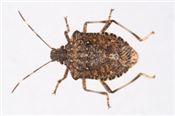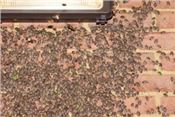They’re Here: Stink Bug Invasions Have Begun!

Figure 1: Brown marmorated stink bugs are speckled with brown, grey, and gold. They also have white bands on their antennae. When outside
they can be pests of numerous crops. But, in the fall and winter they take on a new role as a home invading pest.
Photo: Jim Kalisch, University of Nebraska-Lincoln
DR. JONATHAN L. LARSON
PRINCETON, KEN.
Brown marmorated stink bugs have begun their annual trek to get inside of your home. This yearly annoyance is something that parts of the state have been experiencing for a while, but other counties may have just started to deal with this. Here is a primer on what’s happening and what you can do to try and curtail these stinky houseguests.
What is a brown marmorated stink bug?
Brown marmorated stink bugs (also known as BMSB) are an invasive species as well as “true bugs”-meaning they have needle-like mouthparts. Overall, these pests are shield-like in shape and a little over ½ inch in length. They get their name from their mottled brown and grey coloration. BMSB may damage garden plants, such as tomatoes and peppers, as well as tree fruits, such as apples and peaches, amongst others.
Why are they coming into my house?
Insects don’t like the cold. Some insects are able to survive being frozen and others prevent being frozen by producing antifreeze compounds internally. Others try to escape the cold. In this group we have some species that migrate away from cold weather in order to survive. The most famous example of this is the monarch butterfly, which spends the winter in Mexico before they migrate north the following year. Then there are others that hide from the cold by finding somewhere that stays just warm enough to keep them safe.
Usually this is done by hiding in leaf litter, getting under rocks, or burying into the soil. Other times, they might discover that humans have big, heated domiciles that they can easily sneak into!
BMSB falls into this last group. They overwinter as an adult and our homes mimic their natural hiding spaces with added amenities. Once they enter a home, they aren’t looking to feed or mate. They are simply waiting until spring. They usually enter a sort of arrested phase where they don’t move much. Occasionally though, on warm winter days, they will “wake up” and start crawling around the home.
Once winter is over, they leave their overwintering site in April and May to mate. The female lays eggs from May until August. After hatching, BMSB will develop through five nymphal stages before becoming an adult. Nymphs start out 1/8th inch and red and black; they become larger, darker, and browner as they develop. In September and October, adults begin searching for overwintering sites to start the cycle anew next year.
What can I do?
The best thing to do is to start preparing in late summer.
Inspect your home and check for cracks around windows, doors, pipes, and chimneys and seal openings with silicone or silicone-latex caulk.
You can consult another KPN article for more information on pest- proofing and using insecticides on the outside of the home.
Turning off exterior lights or switching to non-insect attracting bulbs will reduce stink bug interest in your structure.
If stink bugs are found inside, simply vacuum up living specimens and dispose of them outside.
Using bug bombs or other insecticides in the home will not help to deal with stink bugs and will only serve to expose the people inside to residues. ∆
DR. JONATHAN L. LARSON: Entomology Extension Specialist, University of Kentucky
 Figure 2: Brown marmorated stink bugs use our homes and other building to escape from exterior temperatures.
Figure 2: Brown marmorated stink bugs use our homes and other building to escape from exterior temperatures.
Hundreds of them can invade a single home, a major annoyance for the humans also just trying to get through the winter months.
Photo: Leske, from Texas A&M AgriLife Extension